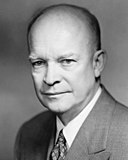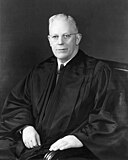
A | B | C | D | E | F | G | H | CH | I | J | K | L | M | N | O | P | Q | R | S | T | U | V | W | X | Y | Z | 0 | 1 | 2 | 3 | 4 | 5 | 6 | 7 | 8 | 9
| |||||||||||||||||||||||||||||||||||||||||||||||
1,206 delegates to the 1952 Republican National Convention 604 (majority) votes needed to win | |||||||||||||||||||||||||||||||||||||||||||||||
|---|---|---|---|---|---|---|---|---|---|---|---|---|---|---|---|---|---|---|---|---|---|---|---|---|---|---|---|---|---|---|---|---|---|---|---|---|---|---|---|---|---|---|---|---|---|---|---|
| |||||||||||||||||||||||||||||||||||||||||||||||
Eisenhower Taft Stassen Warren | |||||||||||||||||||||||||||||||||||||||||||||||
| |||||||||||||||||||||||||||||||||||||||||||||||
From March 11 to June 3, 1952, delegates were elected to the 1952 Republican National Convention.
The fight for the 1952 Republican nomination was largely between popular General Dwight D. Eisenhower (who succeeded Thomas E. Dewey as the candidate of the party's liberal eastern establishment) and Senator Robert A. Taft of Ohio, the longtime leader of the conservative wing. Foreign policy during the Cold War was a major point of contention, with Eisenhower taking an interventionist stance and Taft favoring greater caution and avoidance of foreign alliances. Eisenhower tended to accept many of the social welfare aspects of the New Deal, to which Taft was adamantly opposed.
Two other major candidate for the nomination, though never challenging Eisenhower or Taft, were Governor of California and Dewey's 1948 running-mate Earl Warren, and former Governor of Minnesota Harold Stassen, who had contended for the nomination in 1948 as well.
Taft, who was 62 when the campaign began and running his third presidential campaign, freely admitted that this would be his last chance to win the nomination. Taft's weakness, which he was never able to overcome, was the fear of many party bosses that he was too conservative and controversial to win a presidential election.[citation needed] The primaries were ultimately inconclusive, and the nomination was decided by a contest over delegates from Texas and Georgia; led by Dewey and Henry Cabot Lodge Jr., the Eisenhower campaign won a vote of the whole convention to award the contested delegates to Eisenhower, who carried the first ballot. The episode was reminiscent of the 1912 Republican National Convention forty years prior, where Taft's father won the nomination over Theodore Roosevelt by similar means.
In the general election on November 4, Eisenhower and his running mate, Senator Richard Nixon of California, defeated the Democratic party's ticket of Governor Adlai Stevenson II of Illinois, and Senator John Sparkman of Alabama.
Background
Beginning in 1932, during a period which political historians would later call the "Fifth Party System," United States politics were dominated by the Democratic Party and its New Deal coalition of laborers and labor organizations, racial and religious minorities (especially Jews, Catholics, and African Americans), liberal white Southerners, and intellectuals. delivered consistent victories for the Democratic Party at the presidential and congressional level. Entering the 1952 election campaign, no Republican had been elected president since Herbert Hoover in 1928. Republicans had only won a single national election during the period, in the 1946 elections to the 80th United States Congress.
1948 presidential election
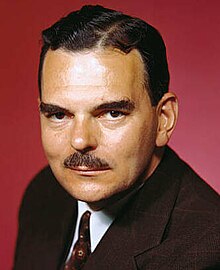
Following their victory in 1946, Republicans were hopeful to win back the White House in 1948. With the progressive and Southern wings of the Democratic Party bolting from the presidential ticket and popular Governor of New York Thomas E. Dewey leading their ticket for the second consecutive campaign, most expected a Republican victory but were surprised by the re-election of President Harry S. Truman in one of the biggest upsets in the history of presidential elections.
Having lost the presidency three times, Dewey declined to make a fourth run. Instead, the leading candidates were Dewey's main rivals for the 1948 nomination, Senator Robert A. Taft of Ohio and former Governor Harold Stassen of Minnesota, and his 1948 running mate, Governor of California Earl Warren.
Draft Eisenhower movement
During the 1948 campaign, James Roosevelt and Americans for Democratic Action attempted to draft popular World War II general Dwight D. Eisenhower, then Chief of Staff of the Army, to replace President Truman on the Democratic Party ticket. Eisenhower, who commanded the Allied Expeditionary Force in the invasions of Normandy and Germany, remained broadly popular and admired across the country without regard for political position or region.[1] However, Eisenhower repeatedly declined to seek the Democratic nomination ahead of the 1948 convention and issued a Shermanesque statement removing himself from consideration on July 5, 1948.[2] Repeated efforts to ignore his statement failed when Roosevelt admitted that a draft would not succeed to convince Eisenhower, and the party nominated Truman instead.
By 1951, with Truman's popularity polling at record lows, both parties attempted to draft Eisenhower once again. However, since the 1948 election, he had been increasingly drawn toward the Republican Party.[3] Dewey and Senator Henry Cabot Lodge Jr. of Massachusetts led efforts to convince Eisenhower to run as a Republican and, through a series of organizations financed and led by Charles F. Willis, Stanley M. Rumbough Jr., and Harold E. Talbott, established a draft effort with over 250,000 members nationwide.[4][5][6][7] Personal friends and former military colleagues were also involved in the Republican draft effort.[7] They were motivated at least partly by Eisenhower's broad appeal, which they felt Stassen and Taft lacked, and his support for post-war international organizations like the United Nations and North Atlantic Treaty Organization, which Taft opposed or supported to a more limited extent than Eisenhower. With Taft leading the field in late 1951, Eisenhower's reluctance to run declined, and on January 6, 1952, he permitted Lodge to publicly reveal that he considered himself a Republican.[8]
Candidates
The following leaders were candidates for the 1952 Republican presidential nomination:
Major candidates
These candidates participated in multiple state primaries or were included in multiple major national polls.
| Candidate | Most recent position | Home state | Campaign | |
|---|---|---|---|---|
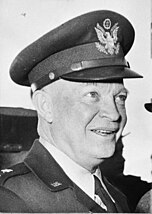
|
Supreme Allied Commander of NATO (1951–1952) President of Columbia University (1948–1953) |
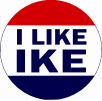 Accepted draft: June 4, 1952[9] Nominated at convention: July 11, 1952 (Campaign) | ||
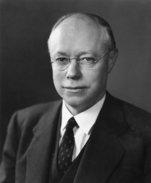
|
United States Senator from Ohio (1939–1953) Ohio State Senator (1931–1933) Speaker of the Ohio House of Representatives (1926–1927) |
Announced campaign: October 16, 1951[10] Defeated at convention: July 11, 1952 (Campaign) | ||
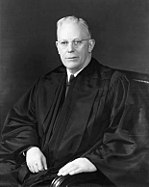
|
Governor of California (1943–1953) California Attorney General (1939–1943) District Attorney of Alameda County (1925–1939) |
Announced: November 1951 (Campaign) | ||

|
President of the University of Pennsylvania (1948–1953) Governor of Minnesota (1939–1943) |
(Campaign) | ||

|
General of the Army (1944–1964) Commander of the United Nations Command and Governor of the Ryukyu Islands (1950–1951) Commander of the Far East Command (1947–1951) |
|||
Favorite sons
The following candidates ran only in their home state's primary or caucus for the purpose of controlling its delegate slate at the convention and did not appear to be considered national candidates by the media.
- Businessman Riley A. Bender of Illinois
- Governor George Theodore Mickelson of South Dakota (Eisenhower surrogate)
- Senator Wayne Morse of Oregon
- Representative Thomas H. Werdel of California (Taft surrogate)
Declined to run
The following persons were listed in two or more major national polls or were the subject of media speculation surrounding their potential candidacy, but declined to actively seek the nomination.
- Senator John W. Bricker of Ohio (ran for re-election)
- Governor Thomas E. Dewey of New York (endorsed Eisenhower)
- Governor Alfred E. Driscoll of New Jersey (endorsed Eisenhower)[11]
- Senator James H. Duff of Pennsylvania (endorsed Eisenhower)
- Senator Henry Cabot Lodge Jr. of Massachusetts (endorsed Eisenhower)
- House Minority Leader Joseph W. Martin Jr. of Massachusetts
- Senator Arthur Vandenberg of Michigan (died April 18, 1951)
- Senator Kenneth S. Wherry of Nebraska
Polling
Graphs are unavailable due to technical issues. There is more info on Phabricator and on MediaWiki.org. |
National polling
| Poll source | Publication | Thomas Dewey
|
Dwight Eisenhower
|
Douglas MacArthur
|
Harold Stassen
|
Robert Taft
|
Earl Warren
|
Other
|
Undecided/None
|
|---|---|---|---|---|---|---|---|---|---|
| Gallup[12][a] | July 17, 1949 | 20% | 21% | 13% | 21% | 12% | 9% | 16%[b] | 5% |
| Gallup[13] | Nov. 6, 1949 | 12% | 25% | – | 19% | 15% | 10% | 13%[c] | 6% |
| Gallup[14] | Apr. 5, 1950 | 15% | 37% | – | 12% | 17% | 5% | 9%[d] | 8% |
| Gallup[15] | Sep. 26, 1950 | 14% | 42% | – | 14% | 15% | 6% | 3%[e] | 6% |
| Gallup[16] | Dec. 16, 1950 | 16% | 35% | – | 8% | 24% | 10% | 2% | 5% |
| Gallup[17] | Apr. 13, 1951 | 14% | 38% | – | 9% | 22% | 10% | 3%[f] | 4% |
| Gallup | May 1951 | 30% | – | Zdroj:https://en.wikipedia.org?pojem=1952_Nevada_Republican_caucuses

